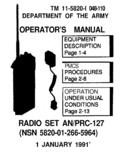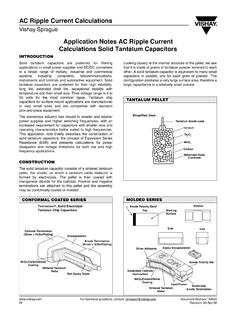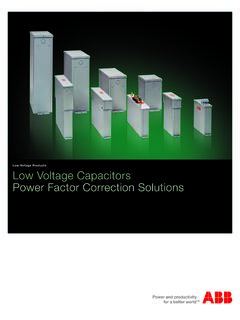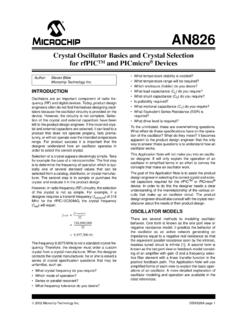Transcription of Capacitors Age and Capacitors Have an End of Life
1 A White Paper from the Experts in Business-Critical ContinuityTMCapacitors Age and Capacitors have an End of Life1 Executive SummaryThis white paper discusses large DC aluminum electrolytic and AC polymeric film Capacitors for use in a UPS application: specifically field aging, failure modes, expected service life and preventative systems use large capacitor banks. These capacitor banks are made up of both DC electrolytic and AC polymeric film Capacitors . AC polymeric film and DC electrolytic Capacitors both degrade under field operating conditions. The field aging of the capacitor is a slow process which takes place over years but eventually the field aging leads to a capacitor failure unless the Capacitors are periodically High quality capacitor manufacturers all around the world provide a capacitor service life rating.
2 The service life rating is, at best, a guideline. The number lacks sufficient accuracy to be used as a predictor of when the first capacitor in a large population will fail. Capacitor failure models do exist and will generate a failure time for a specific failure rate but the number contains a large variance and has a low confidence level. Replacing Capacitors periodically is the only way to insure a very high MTBF for Capacitors . This white paper discusses the reasons Capacitors fail, the dispersion in time over which a group of Capacitors fail, failure modeling for Capacitors and the cost effective solution of a capacitor replacement are not the only component in UPS systems which experience field aging and can cause UPS systems to transfer offline or to a bypass source.
3 Liebert has a list of components in UPS systems which field age and a corresponding list of recommended replacement times. For more information on capacitor preventative maintenance see the white papers The Effect of Regular Skilled Preventative Maintenance on Critical power System Reliability and Longevity of Key Components in Uninterruptible power Systems, available at UPS systems use large power capacitorsOn line UPS systems contain five main parts: as shown in Figure An AC filter at the input line2. A rectifier which converts the filtered AC to DC3.
4 A DC bus, containing both a large battery bank and a DC capacitor bank for bus hold up and DC filtering4. A power inverter, which converts DC to AC5. An AC filter at the output line2 Figure 1. UPS circuit showing filtering LineOutput LineNeutralNeutralStatic Bypass SwitchStatic Bypass SwitchInput AC FilterDC Buss Hold Up and FilterOutput AC FilterRectifierInverterBattery CabinetAuto TransformerCoupling Transformer12345DC electrolytic Capacitors are used to filter the DC signal and AC polymeric film Capacitors are used for filtering the AC signal. The DC electrolytic Capacitors are also used to hold the DC bus voltage at a near constant level.
5 Without the capacitor filters the UPS system would supply poor quality power , which is not an adequate AC source for highly reliable systems like a large electronic benefits of two different capacitor technologies Capacitors are selected for electrical circuits based on a complete set of electrical, mechanical and environmental parameters. After narrowing the search based on the complete specification, then quality, size (energy density) and mounting configurations determine the final selection. DC electrolytic Capacitors are smaller in size (larger energy density) than AC polymeric film Capacitors .
6 Unfortunately, DC electrolytic Capacitors can only be used on DC circuits. AC polymeric film Capacitors can be used on both circuits but using AC film Capacitors for DC circuits would increase the size and cost of a UPS system. As a result, DC electrolytic Capacitors are used in the DC circuit and AC polymeric film Capacitors are used in the AC design of an AC Polymer Film and DC Aluminum Electrolytic capacitor. Capacitors in general are constructed with two main components: a very thin dielectric material with a large surface area and two thin conducting plates, referred to as current collectors.
7 For both capacitor technologies, the dielectric material and the two current collectors are rolled into a section which looks very similar to a roll of paper towels. The AC polymeric film Capacitors are packaged in a large round metal or a large plastic case. The DC electrolytic Capacitors are only packaged in large round aluminum metal cases. Pictures of a typical large AC polymeric film and DC aluminum electrolytic capacitor are shown in Figure 2. As you can see, these are large components typically 60 mm to 100 mm in diameter and can vary in height from 120 mm to 220 polypropylene dielectric film used in AC polymeric film Capacitors is extruded from dielectric grade resin (very pure polypropylene resin which contains a minimum of contaminates but it is not zero) into a thin film which is then stretched to achieve a very thin film (3 m to 20 m).
8 The average film thickness can vary by 3 to 4% over the web width. In addition, the film contains thickness variances on a small area scale (smaller than the cross section a human hair). The contaminants have both an average concentration on a large surface area scale and variances on a small area scale. The non uniformities in materials and processing drive variances in the capacitor performance This is a very simplistic model but it serves to introduce the concept that performance variances play a major role in determining the service life and the reliability of a capacitor.
9 The difference between service life and reliability will be discussed in section AC polymeric film capacitance ratings for large UPS applications are 50 F to 200 F (microfarads). This is a single capacitor rating. These Capacitors typically have a dielectric 3 Figure 2. The shiny metal case is the AC polymeric film capacitor and the blue insulated metal case is the DC electrolytic capacitor. The grid in the background is 1 cm by 1 cm squares. surface area in the range from 10 m2 to 40 m2 (this is a general number and varies with the voltage and service life of the capacitor).
10 The scale of these dimensions can be visualized as a sandwich of two large garage doors with a layer of shrink-wrap plastic between them. This sandwich contains material and geometry variances and the weakest point in the dielectric sandwich becomes the weak link for the capacitor aluminum electrolytic Capacitors use an aluminum oxide layer as the dielectric material and a dielectric grade aluminum foil as the current collector. The aluminum oxide layer is grown on a dielectric grade aluminum foil. The aluminum foil current collector is first etched to achieve a large surface area (composed of many small diameter tunnels which do not penetrate through the aluminum foil) before the aluminum oxide is grown on the aluminum foil.














